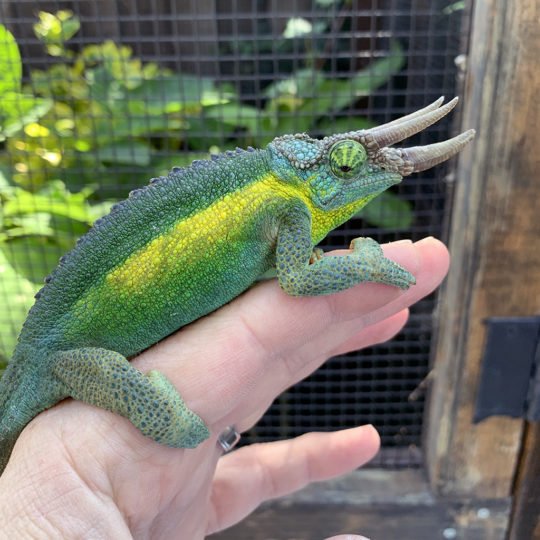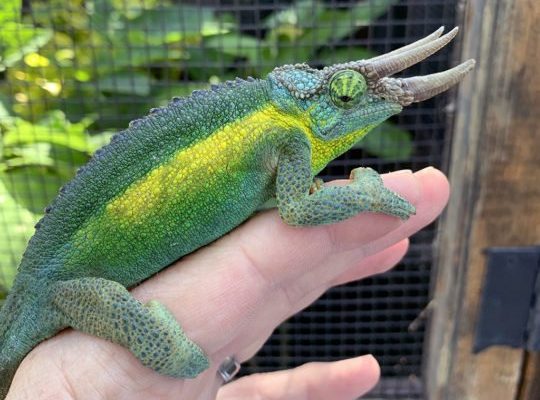
Caring for an Oustalet’s Chameleon isn’t just about feeding it and providing some branches to climb on. It involves understanding their specific needs, behaviors, and habitat requirements. You’ll want to create a home that mimics their natural environment as closely as possible. We’ll dive into the do’s and don’ts of chameleon care, helping you avoid common pitfalls while ensuring your new friend gets the best life possible.
Understanding the Oustalet’s Chameleon
The Oustalet’s Chameleon, or *Furcifer oustaleti*, is one of the largest chameleons. Known for their vibrant colors, they can change their hues based on their mood and environment. If you’re considering getting one, you might be wondering about their size and lifespan. They can reach lengths of about 30 inches and typically live around 5 to 7 years.
These chameleons are native to Madagascar, where they thrive in warm, humid environments. That means if you want one as a pet, you’ll need to recreate that atmosphere at home. This might require a bit of effort, but trust me, it’s worth it for the stunning display of colors and quirky behaviors you’ll witness.
While the Oustalet’s Chameleon is known for its resilience, it’s still important to know what they need to stay healthy and happy. Let’s look at some essential do’s and don’ts to keep in mind as you embark on this exciting journey.
Do: Create the Right Environment
First things first—your Oustalet’s Chameleon needs a proper environment. Imagine trying to work in a noisy, cluttered space; it wouldn’t be very productive, right? Well, your chameleon feels the same way.
You want to ensure their habitat has plenty of climbing branches, plants, and hiding spots. A tall terrarium is ideal, allowing them to explore vertically. Here’s a quick checklist for setting up their home:
- Size: Aim for a terrarium that’s at least 3 feet tall.
- Plants: Use live plants like pothos or hibiscus for humidity and hiding spots.
- Temperature: Maintain a basking spot of about 85-90°F and a cooler area around 75°F.
- Humidity: Keep humidity levels between 50-70%—misting helps!
Remember, the right environment leads to a stress-free chameleon, which means a happier pet and less chance of health issues down the line.
Don’t: Overdo the Handling
You might be eager to hold your new chameleon, but here’s the thing: they don’t always appreciate being handled. Oustalet’s Chameleons prefer to observe their surroundings from a perch rather than being picked up. Too much handling can cause them stress, affecting their health and overall behavior.
Instead of frequent handling, let them get comfortable in their habitat first. You can spend time near their enclosure, talking to them softly. Once they seem more relaxed, you can try offering a treat—like crickets or worms—while they’re on a branch to build trust.
If you do decide to handle them, make it quick and gentle. Always support their body and avoid sudden movements. They’ll appreciate your patience!
Do: Focus on Nutrition
Just like you wouldn’t survive on junk food alone, your chameleon needs a balanced diet. The Oustalet’s Chameleon primarily eats insects. Here’s a quick breakdown of what to include in their menu:
- Staples: Crickets, mealworms, and roaches are excellent choices.
- Variety: Offer different insects to provide essential nutrients.
- Supplements: Dust their food with calcium and vitamin powders regularly.
If you’re wondering how often to feed them, younger chameleons tend to eat more frequently—every day is ideal—whereas adults might only need food every other day. Keep an eye on their weight, and adjust accordingly.
Feeding time can be a fun bonding experience. Watching your chameleon catch its prey is captivating and lets you see their natural hunting instincts in action.
Don’t: Ignore Health Signs
You might think your chameleon is just a little shy or moody, but ignoring health signs can lead to serious consequences. Watch for any changes in behavior, such as decreased appetite, lethargy, or abnormal color changes. These can be indicators that something is wrong.
If you see your chameleon staying very still or basking excessively, it might be stressed or unwell. Here are a few signs to keep an eye on:
- Weight loss or refusal to eat.
- Abnormal droppings—check for color and consistency.
- Respiratory issues, like wheezing or bubbles around the mouth.
If you notice any concerning signs, don’t hesitate to consult a reptile vet. Early intervention can make a huge difference.
Do: Maintain Cleanliness
Keeping your chameleon’s habitat clean is a no-brainer but often overlooked. A dirty environment can lead to health problems, including infections.
Here’s how to maintain cleanliness:
- Spot clean: Remove uneaten food and waste daily.
- Complete clean: Do a deep clean of the terrarium monthly, replacing substrate and cleaning decor.
- Water: Change their water daily and clean the water bowl to prevent bacteria growth.
By keeping things tidy, you’re not just creating a pleasant living space—you’re also promoting a healthier environment for your pet.
Don’t: Neglect Lighting and UVB Needs
Lighting is crucial for your chameleon’s health. Just as we need sunlight for vitamin D, chameleons require UVB light to metabolize calcium. Neglecting this can lead to serious health issues like metabolic bone disease.
You’ll want to ensure your chameleon has access to both basking light and UVB light. Here’s what to consider:
- Use a UVB bulb specifically designed for reptiles—avoid using regular bulbs.
- Replace the UVB bulb every six months, as its effectiveness decreases over time.
- Position the bulb correctly; the UVB should reach the basking area without being too close to avoid burns.
This lighting setup mimics their natural habitat, allowing them to thrive and stay active.
Caring for an Oustalet’s Chameleon can be a rewarding experience, filled with colorful moments and fascinating behaviors. By following these do’s and don’ts, you’ll create a thriving environment for your pet. Remember, patience and understanding are key.
Every chameleon is unique, so take the time to learn what works best for yours. With the right care, you’ll be rewarded with the joy of watching your chameleon flourish. So, prepare for a colorful adventure that adds a bit of magic to your life!

